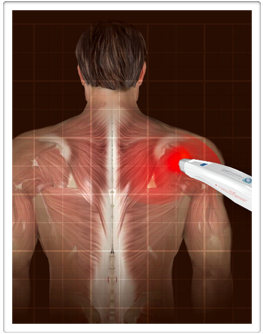
Does your shoulder ache whenever you move it above your head or behind your back? If so, you may have torn your rotator cuff. This small band of tendons can tear either in one big accident, or gradually wear down over time. Postural awareness and gradual painfree strengthening will be the key to getting your shoulder back in the game!
The Malady: Rotator cuff tear
The Facts: The shoulder is a joint that is composed of the arm (humerus) bone and shoulder blade (scapula), which form a ball and socket joint. The rotator cuff is composed of the tendons from 4 muscles (the supraspinatus, infraspinatus, subscapularis, or teres minor). Any or all of these can become torn, although the first two are the most common. The tendons run in between the ball and the socket, and act to push the ball down relative to the socket to allow it to glide smoothly.
The Symptoms: Patients with a torn rotator complain of pain when they lift their arm, usually overhead or behind their backs. The pain is located deep in the shoulder joint, and can be mild to severe. Pain can also radiate down the arm, usually no more than several inches down, but can go as far down as the forearm in severe cases. Patients often complain of pain while sleeping. Pain usually occurs with movement while awake, but can also be present at rest with severe cases.
What is Happening: With a rotator cuff tear, a piece of tissue, specifically one or more rotator cuff tendons, gets stuck in between the ball and socket when the arm elevates or is compressed. As a result, the pressure from the ball rubbing up against the structure causes irritation and inflammation, and results in painful motion. It can also occur from blunt force, as the small tendons, which can only withstand several pounds of force, are made to resist a big compressive or stretching force, and cannot withstand it, causing a tear.
Why Is This Happening: Rotator cuff muscles can tear as a result of an injury, where the muscle is overstretched or the shoulder is landed on, or from throwing or climbing. However, they can also wear down over time, which makes the threshold for tearing much lower. If the mid back muscles that surround the shoulder blade (specifically the lower and middle trapezius muscle) are weak, then the shoulder blade will not rotate properly along with the arm bone. If the arm rotates and the shoulder blade doesn’t, the tissues between the ball and socket (i.e. the rotator tendons) can get pinched. This can also occur due to rotator cuff weakness. Weakness in these muscles will cause the ball to be too high in the socket, and grind against the tissues that pass in between them. Strong rotator muscles can push the ball away from the socket and allow proper movement.
Lifestyle Adjustments:
1) Sit up! Keep your back straight and your belly button pulled in
2) Be aware! Set alarms on your phone to remind you to exercise good posture
3) Get in shape! Keeping good muscle tone throughout your body will make you resistant to injury
Prevent It
1) Know your limits! Do not play contact sports unless in proper physical shape
2) RICE up! Rest, Ice, Compress, and gentle Elevate the arm after mild injury to prevent further tearing
3) Push forward! Pull your shoulder blades back and your chest forward when you sit or stand to prevent from slumping
Fix It The fix for this malady is the same as the prevention: stop performing irritating activities, and start strengthening your weak muscles! Shoulder exercises must be performed painfree, so stop if you experience any pain, rest and ice for several days, then try again. Contact your PT for some strengthening exercises!
